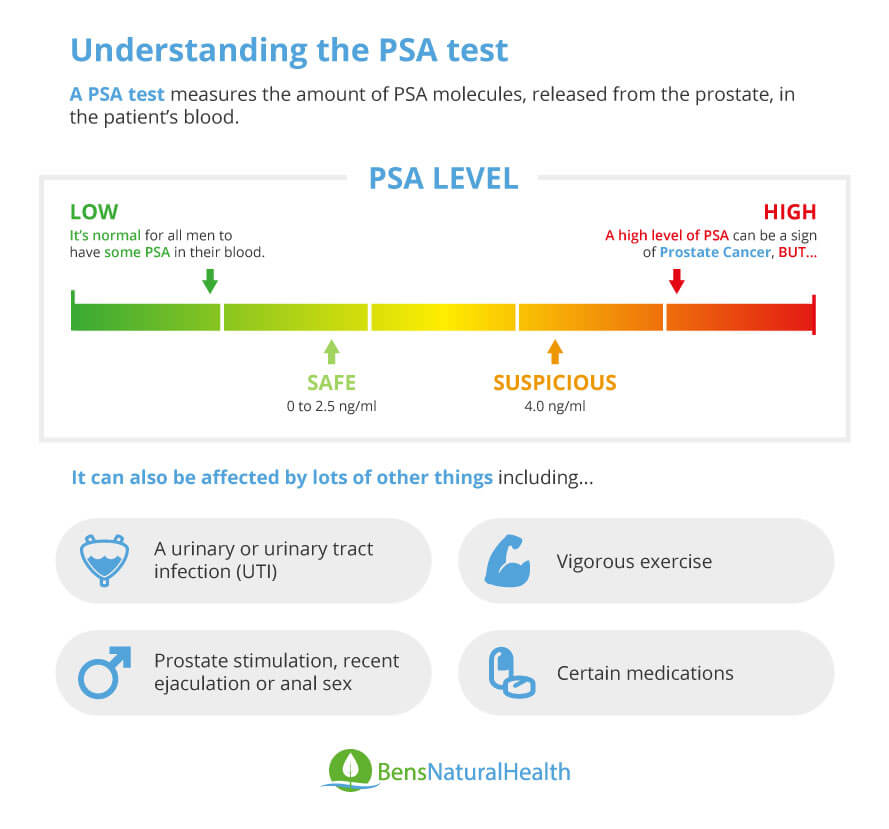- Who should get tested?
- What causes PSA elevation in the blood?
- How often should a PSA Test be done?
- Limitations of a PSA Screening
- Prostate cancer and the PSA Test
- Potential benefits and harms of a PSA screening
- Free and Total PSA
- PSA density, velocity, and age-related PSA consideration
- Other tests for prostate cancer screening
- Conclusion
- Source
Prostate-specific antigen (PSA), is a protein produced exclusively by the male prostate gland. It is a normal secretion of the cells of a healthy gland. The PSA test measures the level of this antigen in a blood sample.
Approved by the FDA in 1986, many doctors widely use the test as part of routine blood work in annual exams.
With the adding of the PSA test to routine blood work for men over fifty, the risk for a man to be diagnosed with prostate cancer increased substantially.
For many men, their first indication of a problem is when blood work from routine annual physical results in an abnormal PSA reading.
The normal range is considered to be from 0 to 4 nanograms per milliliter (ng/mL) of blood. Often, especially for older men, the upper limit is exceeded.
Thus begins a cycle of apprehension that the elevated PSA reading is an indicator of prostate cancer.
Get Your FREE PSA Lowering Diet Plan!
- Naturally lower PSA levels
- Reduce nighttime trips to the bathroom
- Enjoy better bladder control and urine flow
Who should get tested?
A cancerous growth within the prostate can certainly cause a man’s PSA level to rise significantly, there are many other factors that can also cause PSA to rise.
Doctors often recommend PSA screening for all men over fifty. However, the US Preventive Services Task Force (USPSTF) recommends that healthy men over 70 years old with no symptoms not be screened.
Other professionals recommend that PSA screening not be undertaken for men who are symptomless and at low risk for prostate cancer.

What causes PSA elevation in the blood?
An elevated PSA can result from a number of factors, including:
- Prostatitis.
- A urinary infection.
- Bicycle or horseback riding.
- Recent or unusual sexual activity.
- An enlarged prostate (benign prostatic hyperplasia).
- Aging.
- Digital rectal exam.
It is quite common for a man to have an elevated level that drops back to normal within a couple of weeks.
Perhaps the smartest thing any man with an elevated PSA at an annual exam can do is schedule another test in about 60 to 90 days.
If the second test confirms the first, or if the level increased in this short period, additional evaluation can be initiated.
If the elevated level is due to an external event such as one of the ones mentioned above, it will usually drop back to its previous value.
It is prudent for a man to keep his own records of PSA testing over the years.
In this manner, PSA fluctuations can be compared to prior year records, and the significance of a single elevated reading can be evaluated.
An older man, armed with several years of PSA records is much less likely to be subjected to a biopsy, especially if he has a history of BPH (enlarged prostate).
While the PSA test alone is not specific for prostate cancer, records showing a slow increase over several years in a man with BPH can provide the clinician with valuable information.
Since the only relatively positive way to conclusively diagnose prostate cancer is via a biopsy, many doctors order one routinely. In a biopsy, small tissue samples are removed for analysis under a microscope for cancer cells.
How often should a PSA Test be done?
There is no well-established interval for PSA testing. Most doctors recommend yearly screening. An elevated PSA often results in a prostate biopsy, which carries its own set of potential side effects.
The American Cancer Society recommends men at average risk of prostate cancer be screened from age fifty. Recently, the USPSTF updated its recommendations for screening to exclude men over seventy.
Screening for prostate cancer should be an individual decision based on a man’s age, health, and any prior screening results.

For more information on what causes PSA levels to rise, click here.
Limitations of a PSA Screening
For many men, PSA screening is automatically ordered for a man along with general blood tests at an annual exam.
While this is probably unnecessary for symptom-less men under fifty, it does allow for a baseline PSA to be established.
The baseline values can then be used as a reference for future testing. Some men will have normal values that stay essentially constant as they age, and others will have an age-related rise.
According to the USPSTF, for men aged 55 to 69 years, a decision to undergo periodic PSA-based screening for prostate cancer is optional. It should include a complete discussion of the potential benefits and harms of screening.
While the actual test (a simple blood draw) poses no problems, the repercussions of an out-of-range PSA level can result in additional unneeded testing and potential complications.
For example, if a man’s PSA exceeds the upper limit (currently 4.0ng/ml), he is often referred to a urologist for a biopsy.
A biopsy has the advantage of being able to detect prostate cancer early, but it has its own set of side effects and complications.
Since prostate cancer is generally non-aggressive and slow-growing, detection can become more of a hardship than the disease.
Most biopsies today use take multiple core samples of the prostate to increase the likelihood of finding cancer. However, this also increases the seriousness of biopsy side effects.
In a recent study of a group of men diagnosed with cancer, whose prostates were surgically removed and reexamined post-surgery, the researchers found significantly fewer cancers than expected. In addition, even with multiple core sampling, it is possible that a cancerous tumor is missed. (2)
Prostate cancer and the PSA Test
Prostate cancer is one of the most commonly diagnosed conditions for older men. A man has about one chance in six of being diagnosed with it during his lifetime.
However, it is typically a very slow-growing cancer that is diagnosed mostly in men over 65 years old.
About ten percent of the cases diagnosed are aggressive enough to be life-threatening. Often the men diagnosed have other serious health conditions that can be far more life-threatening than prostate cancer.
Many factors can cause PSA to rise other than prostate cancer, including BPH (benign prostatic hyperplasia), prostatitis, and urinary tract infections (UTI).
Therefore a high PSA level does not always indicate cancer, and so this is not a definitive test.
The test only measures the antigen level and cannot determine the presence or absence of cancer.
A man with a normal level may still have prostate cancer. Similarly, an elevated level is not an automatic indicator of cancer.
Unfortunately, many men that have a solitary elevated PSA result are immediately scheduled for a prostate biopsy, a procedure that, in itself, carries significant risks.
Then, if any cancer is found, surgery or other aggressive treatment is recommended. This ignores the fact that even if cancer is found, there are many to address it.
An initial diagnosis of prostate cancer should be treated as an informational item used for making subsequent decisions, not an indication for immediate aggressive treatment.

For more information on prostate cancer, click here.
Potential benefits and harms of a PSA screening
The goal of PSA testing is to find aggressive prostate cancer at an early enough stage to be successfully treated.
False-positive test results where the PSA is elevated, but the man does not have prostate cancer are common. They tend to increase with age, thus making an older man more likely to incur a biopsy and additional treatments.
Older men are more likely to have complications after a prostate biopsy. These complications may include; infection, pain, blood in the semen or urine, and erectile dysfunction. (3)
Infection after a biopsy is a serious concern and occurs in more than seven percent of patients. It can result in subsequent hospitalization and life-threatening septic events. (4)

For more information on the potential side effects of a prostate biopsy, click here.
Free and Total PSA
PSA is distributed in the bloodstream in two forms. One form is the usual test measurement, called the total PSA, and is bound to other proteins.
The second form is a small percentage of the first and is known as free PSA. In a healthy prostate, more than 25 percent of the PSA is in the free form. In a cancerous prostate, the free form is a much lower amount, typically less than 10-12 percent.
Many doctors routinely order a PSA test without specifying free PSA. Both free and total PSA can be obtained from the same blood sample; thus there is little valid reason for not ordering both.
Knowing the free PSA level adds to the information gained and helps with decision-making.
It is critical to do personal research as well. Many uninformed men view elevated PSA levels as a diagnosis of prostate cancer.
However, it is an unreliable indicator, and many other factors should be considered before proceeding further.

PSA density, velocity, and age-related PSA consideration
Benign Prostate Hypertrophy (BPH) is a term for an enlarged prostate. It is a common condition in older men and unless it causes urinary problems, it is usually not a serious issue.
Generally, the larger the prostate, the higher the PSA level. PSA density is a calculation of the actual prostate size (determined by a scan or trans-rectal ultrasound) with respect to a normal-sized prostate.
The value of PSA for a normal prostate is adjusted by the measured-size-to-normal-ratio, allowing for a higher PSA for an enlarged prostate. PSA levels tend to rise with age, but there are no generally recognized age-specific reference ranges.
Another important factor is the velocity of a PSA rise. This is where year-by-year records are invaluable. If the yearly records show a small yearly rise, (less than 0.75 ng/mL), the likelihood of cancer is reduced.
Men with BPH often have a slow and steady rise in PSA with time. Small fluctuations in PSA from measurement to measurement are also typical for men that have an enlarged prostate.
A significant rise in PSA value over a short period of time is cause for concern and indicates a need for immediate further medical evaluation. A cancerous prostate will usually have a substantial rise in PSA level, sometimes over very short intervals.
Since PSA can become elevated by several other factors unrelated to cancer, it is prudent to wait at about 60 days and take a second PSA reading before any further procedures.
This is especially true if there is a urinary infection or prostatitis present. Chronic prostatitis is common in older men and can cause a permanent elevation of PSA.

For more information on prostatitis click here.
What the results mean
If the level of a follow-up test has gone down significantly, the sudden elevation was likely due to an external event such as; a long bike ride, recent sex, etc., or a temporary rise due to inflammation (prostatitis) or a urinary tract infection.
If the level has gone up more than a point or so, it may indicate the presence of a prostate tumor and is indicative of a need for further analysis.
Other tests for prostate cancer screening
A recent arrival is called the prostate cancer antigen 3 (PCA3) test. This test detects genetic material that is produced only by prostate cells. Higher amounts of PCA3 are produced by cancerous prostate cells.
The PCA3 test is performed on urine. It is a two-part test with the first part being a digital rectal exam (DRE) where the clinician inserts a gloved finger into the rectum and massages the prostate manually.
This manual manipulation forces the prostate to expel PCA3 into the urine. The urine is collected immediately for examination, and the level of PCA3 in it is then measured.
The testing laboratory reports a score based on a ratio called the PCA3 score.
The PSA level is also typically included in the ratio calculation. PCA3 ratios of up to 17 generally indicate a low possibility of finding prostate cancer with a biopsy. While ratios above 31 are associated with an increased probability of a positive biopsy.
The PCA3 test was approved by the FDA in 2012 and is primarily used to help determine the need for repeat prostate biopsies in men over 50 that have had a high PSA, but a negative biopsy.
A negative result is associated with a decreased likelihood of a positive biopsy. Therefore, this test is not a substitute for a PSA test or a prostate biopsy.
The PCA3 is currently used in conjunction with other patient information to help determine a path for treatment. It is most useful in men with diagnosed prostate cancer using a “watchful waiting” approach to help them avoid repeated biopsies.
Conclusion
The PSA test is a valuable tool for early detection of problems in the prostate. The test itself cannot be used to determine the presence or absence of prostate cancer.
But, it is useful to generate additional information that can help determine both a diagnosis and a treatment plan. A drawback of PSA screening for prostate cancer is that it can often lead to overdiagnosis and overtreatment of non-aggressive cancers. (5)
Mark Stolz, MD6, executive director of the Prostate Cancer Research Institute, and co-author of “Invasion of the Prostate Snatchers” writes that a recent study in the New England Journal of Medicine concluded that out of the fifty thousand prostate operations performed annually, more than forty thousand are unjustified.
In summary, while a PSA test is useful, it needs to be viewed as simply a tool to obtain more definite information.
However, because of an elevated PSA blood test, many men are led towards a major surgical procedure that may not improve the outcome of their disease.
Men that enter surgery unaware or minimally aware of the potential sexual side effects can be devastated when they realize, often many months after the procedure, that incontinence may now be a way of life, and that normal sex life is history.
Explore More







